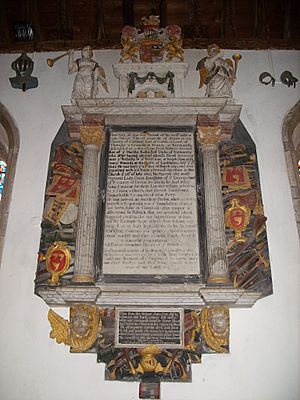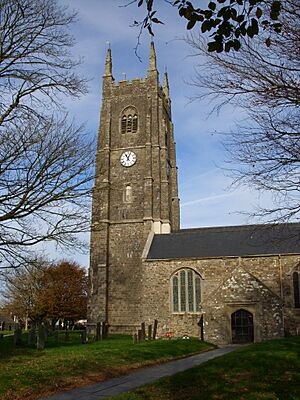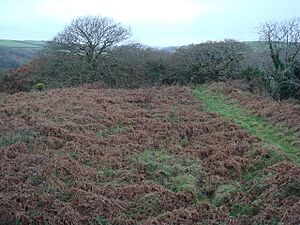Kilkhampton facts for kids
Quick facts for kids Kilkhampton
|
|
|---|---|
| Lua error in Module:Location_map at line 530: Unable to find the specified location map definition: "Module:Location map/data/Cornwall (mainland)" does not exist. | |
| Population | 1,368 (Civil Parish, 2011) |
| OS grid reference | SS253113 |
| Civil parish |
|
| Unitary authority | |
| Ceremonial county | |
| Region | |
| Country | England |
| Sovereign state | United Kingdom |
| Post town | BUDE |
| Postcode district | EX23 |
| Dialling code | 01288 |
| Police | Devon and Cornwall |
| Fire | Cornwall |
| Ambulance | South Western |
| EU Parliament | South West England |
| UK Parliament |
|

Kilkhampton (which is Kylgh in the Cornish language) is a small village and civil parish in the northeast part of Cornwall, England. It's located about 6 kilometers (4 miles) north of the popular coastal town of Bude. The village is right on the A39 road, often called the "Atlantic Highway."
Kilkhampton was first mentioned in a very old book called the Domesday Book. This book was written way back in 1086! At that time, the village was known as "Chilchetone." In 2011, about 1,368 people lived in the parish.
Just west of the village, you can find the remains of an old motte-and-bailey castle called Penstowe Castle. This type of castle was built a long time ago, during the Norman period. Even further west, there used to be a grand house called Stowe House. It was built in 1680 but was taken down in 1739. Some of its stones were even used to build parts of Penstowe!
Today, Kilkhampton has many useful places. There's a post office, a primary school, and a community center called the Grenville Rooms. You can also find shops, two pubs, and places for car repairs and farm supplies. Did you know that a crater on Mars has been named Kilkhampton?
Contents
A Glimpse into History
The area around Kilkhampton has a very long history. When the Domesday Book was created in 1086, the land known as "Chilchetone" was very important and valuable. It was a large area with enough land for many farms and animals. There were also meadows, pastures, and a big woodland. This shows that Kilkhampton was a busy and important place even a thousand years ago.
Kilkhampton Church
The church in Kilkhampton is dedicated to St James the Great. It has a beautiful old Norman doorway and a tall tower with eight bells. Historians believe parts of the church might be around 1,000 years old! This church is one of many dedicated to St James along a special route. This route was used by pilgrims traveling all the way to Santiago de Compostela in Spain.
Inside the church, you can see an impressive monument to a Cornish hero named Sir Bevil Grenville. Other interesting parts of the church include its south porch, built in 1567. There are also many old wooden seats with carved ends, called benchends, from the early 1500s.
In 2006, one of the church bells, called the tenor bell, was found to be cracked. After it was fixed, all eight bells were rung together again in September 2007. In the past, there were also small chapels at Stowe House and Alderscombe.
Cornish Wrestling in Kilkhampton
Cornish wrestling is a traditional sport from Cornwall. In the 1800s, exciting Cornish wrestling tournaments were held in Kilkhampton. People would compete for prizes, making these events a fun part of village life.
Famous People from Kilkhampton
Many interesting people have connections to Kilkhampton:
- The famous England rugby union captain, Phil Vickery, grew up in the village. His family still owns a lot of farmland nearby.
- Thomas Greenway was born in Kilkhampton. He later became the Premier (like a leader or governor) of the Canadian province of Manitoba until 1908.
- Sir Bevil Grenville was a Royalist commander during the English Civil War. He was a very brave leader.
- Henry Robinson was the Rector (a type of church leader) in Kilkhampton during the 1850s.
- The author Adelaide Phillpotts lived in Kilkhampton after she got married in 1952.
See also
 In Spanish: Kilkhampton para niños
In Spanish: Kilkhampton para niños



